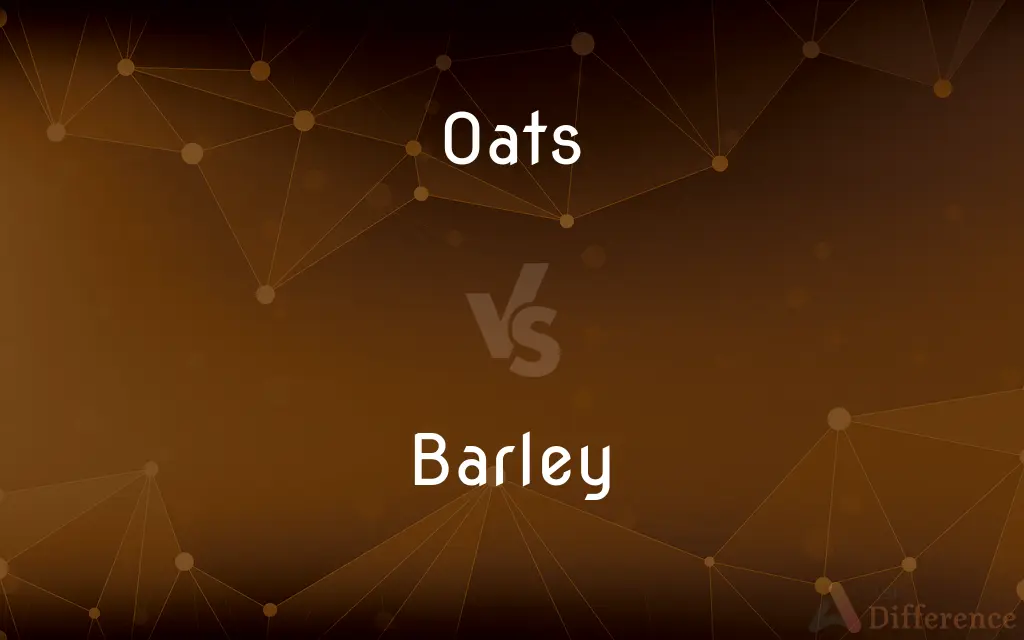Oats vs. Barley — What's the Difference?
By Urooj Arif & Maham Liaqat — Updated on March 25, 2024
Oats are a popular breakfast grain known for their health benefits, while barley is versatile, used in soups, stews, and brewing.

Difference Between Oats and Barley
Table of Contents
ADVERTISEMENT
Key Differences
Oats are primarily grown for their seeds, which are a staple in breakfast foods like oatmeal and granola, known for their high fiber content and health benefits, including lowering cholesterol. They have a distinct, mild flavor and are often rolled or crushed to produce oatmeal or ground into fine oat flour. Barley, on the other hand, is one of the oldest consumed grains, versatile in its uses from animal fodder, to soups and stews, and an important ingredient in beer and whiskey production. It's recognized for its chewy consistency and slightly nutty flavor, and comes in several forms including hulled, pearled, and barley flakes.
Oats are commonly consumed as a breakfast cereal, providing a hearty, nutritious start to the day with benefits such as high soluble fiber content, particularly beta-glucan, which contributes to heart health and stable blood sugar levels. They're often found in forms like rolled oats or steel-cut oats, which differ in texture and cooking time. Barley is more commonly used in savory dishes and as a base for brewing. Its fiber content is high, but it differs from oats in that it contains both soluble and insoluble fiber, promoting digestive health and potentially reducing the risk of certain diseases. Barley grains are typically pearled, where the outer hull and bran layers are removed, which affects its nutritional profile.
In terms of nutritional content, oats are slightly higher in calories and protein but lower in carbohydrates when compared to barley. Oats also contain more fats, which are mostly healthy unsaturated fats that are beneficial for heart health. Barley, while lower in protein and fats, has a higher fiber content than oats, particularly when it comes to insoluble fiber, which is crucial for digestive health. It also tends to have a lower glycemic index than oats, making it potentially better for blood sugar control.
Oats are often preferred for breakfast and baking due to their mild flavor and versatility. They're a popular ingredient in baked goods like cookies, muffins, and bread, where they add texture and nutritional value. Barley is more commonly used in hearty, savory dishes like soups, stews, and risottos. Its ability to absorb flavors and retain a firm, chewy texture makes it a favorite in dishes that require longer cooking times.
Comparison Chart
Primary Use
Breakfast cereals, baking
Soups, stews, brewing
ADVERTISEMENT
Nutrition
Higher in protein and fats, lower in carbs
Higher in fiber, especially insoluble fiber
Flavor
Mild, slightly sweet
Nutty, chewy
Forms
Rolled, steel-cut, flour
Hulled, pearled, flakes
Health Benefits
Rich in beta-glucan, good for heart and cholesterol
Promotes digestive health, may improve blood sugar control
Compare with Definitions
Oats
High in fiber and protein, oats are also rich in antioxidants.
Including oats in your diet can contribute to overall health and well-being.
Barley
Barley is one of the oldest known grains, used in a variety of dishes and beverages.
Barley soup is a comforting and nutritious meal for cold days.
Oats
Oats are a nutritious grain known for their health benefits, especially in lowering cholesterol.
Oatmeal is a popular breakfast choice for a healthy start to the day.
Barley
Barley is nutritious, containing vitamins, minerals, and antioxidants.
Including barley in your diet can provide essential nutrients.
Oats
They can be rolled, crushed, or ground into flour, making them versatile in the kitchen.
Rolled oats are often used in baking cookies and muffins.
Barley
Used in brewing, soups, and stews, barley adds a chewy texture and nutty flavor.
Barley is a key ingredient in traditional beef and barley soup.
Oats
The soluble fiber in oats, beta-glucan, supports heart health by reducing cholesterol.
Regular consumption of oats can lead to lower cholesterol levels.
Barley
It has a high fiber content, especially insoluble fiber, which is good for digestive health.
Eating barley can help improve your digestive system's function.
Oats
Naturally gluten-free, oats are a safe grain for those with celiac disease, although cross-contamination can occur.
Make sure to purchase oats that are certified gluten-free if you're sensitive to gluten.
Barley
Barley has a low glycemic index, which can help in managing blood sugar levels.
Barley can be a good grain choice for people with diabetes.
Oats
Any of various grasses of the genus Avena, especially A. sativa, widely cultivated for their edible grains.
Barley
Barley (Hordeum vulgare), a member of the grass family, is a major cereal grain grown in temperate climates globally. It was one of the first cultivated grains, particularly in Eurasia as early as 10,000 years ago.
Oats
The grain of any of these plants, used as food and fodder.
Barley
A hardy cereal with coarse bristles extending from the ears, cultivated especially for use in brewing and stockfeed.
Oats
A musical pipe made of an oat straw.
Barley
A grass in the genus Hordeum native to temperate regions, having flowers in terminal, often long-awned spikes and widely cultivated for its grain.
Oats
Plural of oat
Barley
The grain of H. vulgare or its varieties, used in malt production and as food for livestock and humans.
Oats
A mass of oat plants (genus Avena, especially Avena sativa).
Oats are in the north corner of the farm.
Usually oats is last in a rotation and does not get the fertilizer that other feed grains get.
Barley
A cereal of the species Hordeum vulgare, or its grains, often used as food or to make beer and other malted drinks.
Oats
Seeds of an oat plant, especially prepared as food.
Oats is a heart-healthy breakfast food.
Oats are good for you.
Barley
(Singapore) seed of Job's tears Coix lacryma-jobi
Barley
A valuable grain, of the family of grasses, genus Hordeum, used for food, and for making malt, from which are prepared beer, ale, and whisky.
Barley
A grain of barley
Barley
Cultivated since prehistoric times; grown for forage and grain
Common Curiosities
What are the main health benefits of oats?
Oats are known for their high soluble fiber content, particularly beta-glucan, which can lower cholesterol and support heart health.
Can barley be used in breakfast dishes?
Yes, barley can be used in breakfast dishes like porridge, offering a nutty flavor and chewy texture.
Is there a nutritional difference between rolled oats and steel-cut oats?
Nutritionally similar, the main difference between rolled and steel-cut oats is in texture and cooking time, with steel-cut oats being chewier and taking longer to cook.
Are there any specific health concerns associated with consuming barley?
People with gluten intolerance or celiac disease should avoid barley, as it contains gluten.
Are oats gluten-free?
Oats are naturally gluten-free, but they may be processed in facilities that handle gluten-containing grains, leading to cross-contamination.
What makes barley a popular choice for brewing?
Barley's enzymes and starch content make it ideal for fermentation, a key process in brewing beer and distilling whiskey.
How does barley's fiber content compare to other grains?
Barley has a high fiber content, particularly insoluble fiber, making it one of the more fiber-rich grains available.
Can oats help with weight management?
Yes, the soluble fiber in oats can help you feel full longer, potentially aiding in weight management.
What are the best ways to incorporate oats into meals?
Oats can be used in a variety of dishes, from breakfast cereals to baked goods and smoothies.
Is pearled barley as nutritious as whole grain barley?
Pearled barley, with the hull and bran layers removed, has a lower fiber and nutrient content compared to whole grain barley.
How can oats contribute to a gluten-free diet?
Oats can be a safe and nutritious part of a gluten-free diet if they are certified gluten-free to avoid cross-contamination.
Share Your Discovery

Previous Comparison
Implementation vs. Onboarding
Next Comparison
Churchwarden vs. VergerAuthor Spotlight
Written by
Urooj ArifUrooj is a skilled content writer at Ask Difference, known for her exceptional ability to simplify complex topics into engaging and informative content. With a passion for research and a flair for clear, concise writing, she consistently delivers articles that resonate with our diverse audience.
Co-written by
Maham Liaqat















































